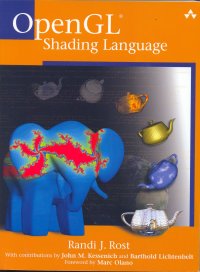The GLSL bump mapping shader code is given below:
[Vertex_Shader]
varying vec3 lightVec;
varying vec3 eyeVec;
varying vec2 texCoord;
attribute vec3 vTangent;
void main(void)
{
gl_Position = ftransform();
texCoord = gl_MultiTexCoord0.xy;
vec3 n = normalize(gl_NormalMatrix * gl_Normal);
vec3 t = normalize(gl_NormalMatrix * vTangent);
vec3 b = cross(n, t);
vec3 vVertex = vec3(gl_ModelViewMatrix * gl_Vertex);
vec3 tmpVec = gl_LightSource[0].position.xyz - vVertex;
lightVec.x = dot(tmpVec, t);
lightVec.y = dot(tmpVec, b);
lightVec.z = dot(tmpVec, n);
tmpVec = -vVertex;
eyeVec.x = dot(tmpVec, t);
eyeVec.y = dot(tmpVec, b);
eyeVec.z = dot(tmpVec, n);
}
[Pixel_Shader]
varying vec3 lightVec;
varying vec3 eyeVec;
varying vec2 texCoord;
uniform sampler2D colorMap;
uniform sampler2D normalMap;
uniform float invRadius;
void main (void)
{
float distSqr = dot(lightVec, lightVec);
float att = clamp(1.0 - invRadius * sqrt(distSqr), 0.0, 1.0);
vec3 lVec = lightVec * inversesqrt(distSqr);
vec3 vVec = normalize(eyeVec);
vec4 base = texture2D(colorMap, texCoord);
vec3 bump = normalize( texture2D(normalMap, texCoord).xyz * 2.0 - 1.0);
vec4 vAmbient = gl_LightSource[0].ambient * gl_FrontMaterial.ambient;
float diffuse = max( dot(lVec, bump), 0.0 );
vec4 vDiffuse = gl_LightSource[0].diffuse * gl_FrontMaterial.diffuse *
diffuse;
float specular = pow(clamp(dot(reflect(-lVec, bump), vVec), 0.0, 1.0),
gl_FrontMaterial.shininess );
vec4 vSpecular = gl_LightSource[0].specular * gl_FrontMaterial.specular *
specular;
gl_FragColor = ( vAmbient*base +
vDiffuse*base +
vSpecular) * att;
}I think that the shader code is rather explicit regarding the previous explanations.
For all the details about texture2D, gl_LightSource, gl_FrontMaterial, varying, attribute, I recommend
to have a look to the Orange Book (of Randi Rost - ISBN: 0-321-19789-5):

Fig.4 - The GLSL language reference bookThe accompanying project includes all the Demoniak3D codes of the scenes of figures 1 and 2. GLSL code is implemented in the
Demoniak3D shader_program node at the level of the torus_bump_mapping_test.xml file.